










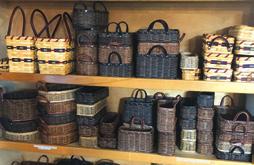

Our farm features 100 local family craft businesses offering hand made products. All locally made!
• Quilts to Brighten Your Home
Discover the beauty of Traditional Amish Quilts with wide selections of King, Queen or Single.
• Country Gifts & Crafts
The ultimate gift waits for you including souvenirs, Quillows, hand bags & purses, leather goods, things for the kids, for your baby, and more!
• Body Care
All natural body care made in Lancaster County, PA, including lotions, soaps, lip balm and more.
• For the Home
Decorate your space and bring it new light including kitchen items, home decor, pillows, lap throws, wall hangings, bird houses & feeders, brooms and more.
Mon.–Sat. 8 a.m.–5 p.m., CLOSED SUN Evenings by appointment only. For our catalog or information call

247 East Eby Rd., Leola, PA 17540
From Rt. 340 take Rt. 772 West. Right on Stumptown Rd. then right on Eby Rd.
We’re the First Farm on the Left — LOOK FOR OUR SIGN! Whether

Travelers have been traversing Lancaster County along Route 30 for well over two centuries. And for over 70 years, a very special building has signaled their arrival in Amish Country. It has a legitimate claim on being the area’s oldest visitor landmark. Most importantly, it’s the “place that made shoo–fly pie famous.” That iconic structure is the Dutch Haven windmill.
With a history dating back to the beginnings of tourism here, the building is rich in memories. From the time it started as a luncheonette in 1920 right up to the present, it has remained most famous for shoo–fly pie, served warm with whipped cream. The Dutch Haven shoo–fly pie has even been mentioned in a TIME magazine article.
Today, as soon as you walk in, you’ll be offered a free sample of that same delicious, gooey pie. Some 40,000 pies are baked annually, using the original (secret) recipe. Visitors are still encouraged to “Take one for yourself or send one to someone nice.” You can buy and ship pies home at the store or at their “online shop,” where you’ll find other local crafts as well.
Yes, Dutch Haven is much more than pies, with over 10,000 unique gift items, foods, and collectibles. Some of the most popular are jams, jellies, and canned goods, noodles, cedar chests, hex signs, quilted spice mats, Amish straw hats, jewelry and gemstones, Dutch Delft tiles, Amish dolls, onyx and soapstone animals, trivets, metal stars, Tiffany lamps, Amish romance novels, framed prints, plenty of T–shirts
and postcards, and a tremendous selection of Amish–made outdoor furniture. It’s an eclectic mix, to say the least.
As you explore, you’ll discover lots of other “surprises” around every corner. Expect the unexpected! And don’t forget the Amish–style root beer in the barrel.
Dutch Haven is now open Mondays, Tuesdays and Thursdays 10 a.m. to 6 p.m., Fridays 10 a.m. to 7 p.m., Saturdays 9 a.m. to 7 p.m., Sunday 9 a.m. to 6 p.m. and closed Wednesdays. Visit our website for information. For more info about this Lancaster County landmark, call 717.687.0111. Look forward to your free sample when you walk in under the welcoming arms of the windmill for this truly is the place that made shoo–fly pie famous.






By Ed Blanchette
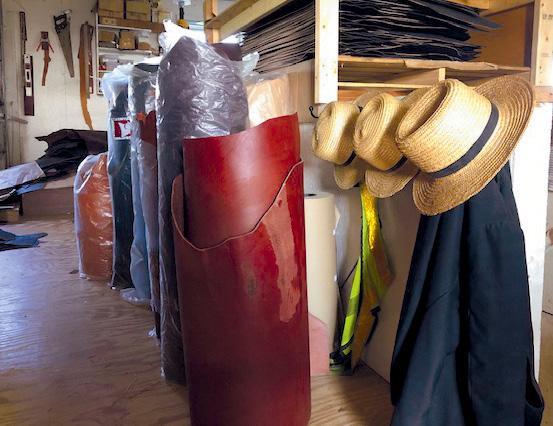
Ihave had the privilege of meeting dozens, maybe even hundreds, of Amish craftsmen over the last decade or so. As the Amish population grows, farmland does not, and out of necessity, Amish people have forayed into various “cottage industries” that they can develop on a small homestead. What may have been borne out of necessity, has in some cases become a treasured pursuit.

The Amish way of life requires leather goods, that we “English” don’t use anymore. You can’t just walk into a Walmart to buy these things, so where do the Amish go? You guessed it, among the Amish there are leather craftsmen who, for generations, have made the things that their community needs.
A trusted, valuable, local business with a strong work ethic, that continues to perfect a time-honored craft within the Amish community and culture for what may truly be generations.
However, at some Amish workshops, it isn’t all about harness and tack. Such is the case at Forest Hill Leather Craft Unlike the lesser-quality strips of hide,

bonded together with adhesives, or synthetic knockoffs, that you might find at big box stores. This is a full-service leather “cottage industry” that uses only the finest leather hides, real 100% pure leather of unmatched quality. Forest Hill Leather Craft offers an array of items, such as briefcases, business planners, women’s handbags & carryalls, coasters, unique gift items, and much more. The main thrust of the business may be belts in almost unlimited lengths, (in stock ranging from 22 inches to 58 inches), and of course these leather belts come available in numerous styles and colors.
Resident craftsman Isaac Stoltzfus opened the doors of Forest Hill Leather Craft after gaining 14 years of experience in working for others. This isn’t just a grumbling job for Ike and his family. No, this is obviously a passion-project for them, as they create wonderfully unique
pieces that last a lifetime. Just out of curiosity, I asked Ike, “Just how big a belt can you make for a custom order?” He said he’s made them up to at least 70 inches in length, but essentially, he can make a belt with almost limitless length. Forest Hill Leather Craft belts
“You can’t just walk into a Walmart to buy leather goods, so where do the Amish go?”
are guaranteed to “last your lifetime” so unlike cheaply mass-produced belts at impersonal big-box retailers (which are often just veneers glued together with very little actual leather involved), an expertly hand-crafted belt from Forest Hills Leather Craft will not need to be
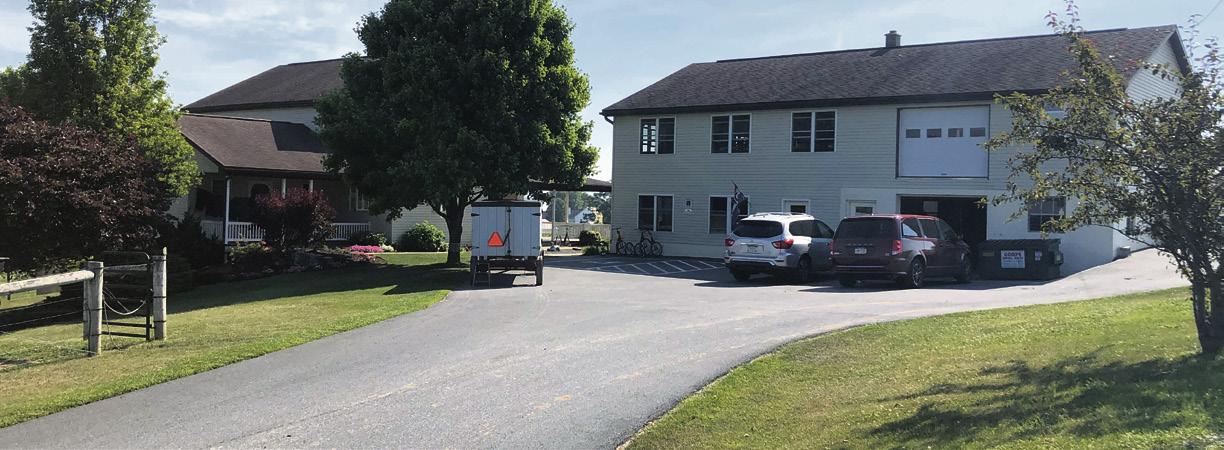
replaced every year or two. A cheap belt becomes a bit more expensive when you think how many times it will need to be replaced, when compared to a lifelong purchase like a belt from Forest Hills
The entire family is involved in one way or another, but Ike, patriarch, and founder of the business, oversees all aspects of production. Assisted by his apprenticing sons, Isaac thoroughly enjoys his work and is very happy to share the finished products with the many people who come through his doors. No matter how young his family members are, all are involved in the business, with the tiniest tots able to at least sweep the floor of the shop. Truly, the epitome of a family business. The leather shop sits in a renovated half of the barn, so while you shop, you often hear the whinnying and nickering of the horses on the other side of the barn, or maybe the crow of a rooster just outside (on my most recent visit I saw the family had a sign proclaiming all-natural, freerange brown eggs for sale.) But the shop is clean, nicely appointed, and spacious, even sporting a mirror to see how the merchandise might look on you before buying.
In early August of 2022, Ike took a three-day trip with his family, which included a tour of the leather tannery im Curwensville Pennsylvania, and a two-day leather workers Auction & Expo in Ohio. This gave Ike the opportunity to meet with suppliers of leather, hardware, and machinery, as well as present his questions and concerns. Ike closed his business for three days to go see, touch, experience, and source the best leathers and supplies available. That’s Ike’s commitment to his craft and to the quality of the product he creates. And that’s the kind of work ethic and quality that you’ll see and find when you look around the Forest Hill Leather Craft shop and feel in your hands when you inspect the wares at this off-thebeaten-path “cottage industry.” Finally, after lots of customer requests, Forest Hill Leather Craft redesigned their popular saddlebag-hoofpick purses into a backpack version. The new design Features the same inside pockets plus a zipper on top to keep everything safe and secure. So, when you head out, getting there couldn’t be easier, but a

word to the wise, his physical address is listed as “Bird-in-Hand” but that is indicative of a quirk of the US Postal system. His property is actually six miles north of the center of Bird-in-Hand, just a short jog north of Route 23 near the town of Leola. Easiest way to get there? Plug 225 Forest Hill Road, Bird-in-Hand, PA 17505 into your GPS. Heading there without a GPS, take Quarry Road north off Route 23 in Leola, and then make a right on Forest Hill Road. The farm is on the right (look for their sign) and is just a short distance after you pass by the Amish one-room school.



By Ed Blanchette

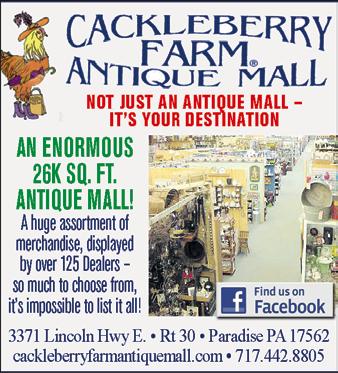


Do you enjoy searching for antiques? Perhaps you are looking for that special something, or you just enjoy searching for a surprise to add to your home decor. Maybe you hope to find an item worthy of an “Antique Roadshow.” Whatever you discover, once you find it, it becomes your personal treasure. What makes Lancaster County such a great place to go antiquing? One obvious answer would be that this area has a rich history going back hundreds of years to the first settlers in the early 1700s. Many of us have stuff in our attics that we have forgotten about, or inherited. Who knows what may be out there either at a yard sale




or an antique shop? Here in Lancaster County we boast thousands of antique shops and dealers. The Adamstown area alone has over 3,000 antiques dealers, and is known as Antiques Capital, U.S.A. The many locations stretch out along Route 272, just off Pennsylvania Turnpike, Exit 286.
Whether you are after a rarity, or just something old that intrigues you, you’ll find everything from sheet music to music boxes, pocket watches to kitchen sinks, nostalgic clothes to beautiful wardrobes to hang them in. Glassware, crafts, toys, clothes, artwork, china, quilts and fabrics, memorabilia...the list is endless!



By Edward Blanchette
As most of you may know, “Amish Country” is a pretty expansive place to live and visit. There is so much going on at any one place or time, it would take me hundreds of pages to cover in just one issue. Recently though, it was brought to my attention by a friend, that I should check out a well deserving organization that has done a lot of good for a bunch of communities over the years. As most of our readership knows, Amish Country News is all about supporting great causes & charities in our own way in and around “Amish Country”. I had connected with Linda Strauss, one of the last founding parent connected to the Homefield {a nonprofit 501©(3) organization}, online and via phone to get permission to do this article, gather information, and visit the care farm. I was received well and gained permission from Linda to write my article. So, I packed up my camera & notebook and headed out to get more information regarding the Homefields Organization Care Farm and see what they’re all about.
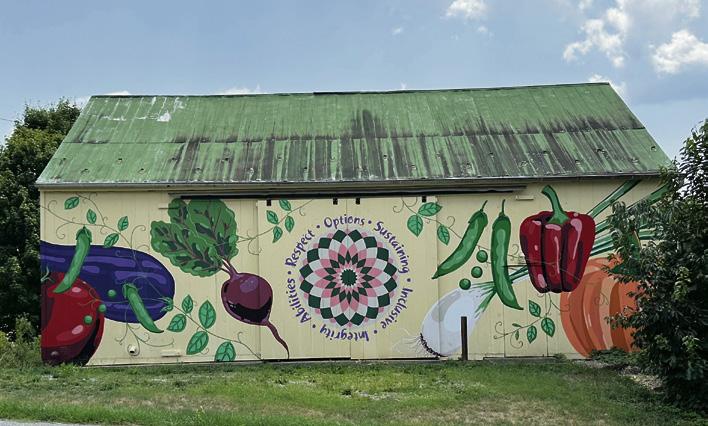

I was made aware that Homefield is an award-winning non-profit organization for over 30-Years, with a 19-acre property/farm that provides jobs, homes, and life options to people with disabilities. Community members from other organizations such as Friendship Community, Community Services Group, and the Occupational Development Center are regular volunteers at Homefield. Homefield and their community supported agriculture (CSA) program is the longest running program in Lancaster County, growing certified organic food for more than 135 families per season. In addition, last season, Homefield
donated over 2,400 pounds of surplus vegetables to food banks such as the Loft Community Partnership and the Lancaster County Food Hub. Recently, Homefield was awarded a $22,000 “Level Up & Launch” grant from the United Way of Lancaster County. This is a matching grant and a great opportunity to support school-aged children as they grow towards independence from four different local high schools to come to Homefields’ Care Farm to learn vocational skills that can lead to a real job for the future. This will continue to allow the Homefield Care Farm to provide an agricultural workforce training program and continue on building long standing relationships with area educational institutions, as

they have from the start. One to bring to mention is Millersville University. Upon arriving in Millersville, PA and at the Homefields Organization Care Farm, I was greeted by Linda directly and warmly. I soon found out that Homefields is a family endeavor from the heart of love for this community. Originated by founders Tom Strauss,

Jr. and wife Linda, along with four other families. Their son Dave Strauss is currently the Homefield Volunteer Chair of Media. Upon approaching a receiving area with Linda, she introduced me to Andrew Phillips, Farm Manager. After greetings and introductions from some of the other staff, Andrew and I headed out for the farm grounds. I was introduced to a few green houses, some crops developed & in-development, a beehive or two, and a fascinating

insect housing model of sorts, that promote an ecological balance of friendly bugs for the farm and their crops, all with a great story. Along with

the multiple buildings on the farm, I was taken to the main barn and on the outside was a huge, beautiful mural that decorated the barn. But the most beautiful part of the farm, in my opinion, were the people. I met Farmhand Christina Waple — a thirdgeneration farmer, Farmhands Cristian Phibbs & Brad Turner, and Assistant Farm Manager Tony Beers among others. It was a great tour to get to know Homefield better.
But the final chapter of my visit was a special tour by Linda Strauss to a special place near to her heart. After a good distance of a walk on a long path, we came to a partially wooded uphill area just outside of one of the fields. There, I was introduced to a specially marked area in remembrance of Tom Strauss, Jr, who passed away in 2022. In this location, there is an “Elyse Jurgen” designed native plant Garden in this south western corner of the farm. Underneath a ginkgo tree that Linda had planted several years ago, located in an unglazed


urn made by Jane Broadbent, a potter and volunteer at Homefields where Tom’s ashes reside. Tom’s wish was to remain with Homefields, and there, under the ginkgo tree, the falling leaves shinning yellow. This spot was truly a warm and beautiful

location. I can see how Tom would love this spot, as it overlooks the majority of the Homefield Care Farm. In that special spot was also a special



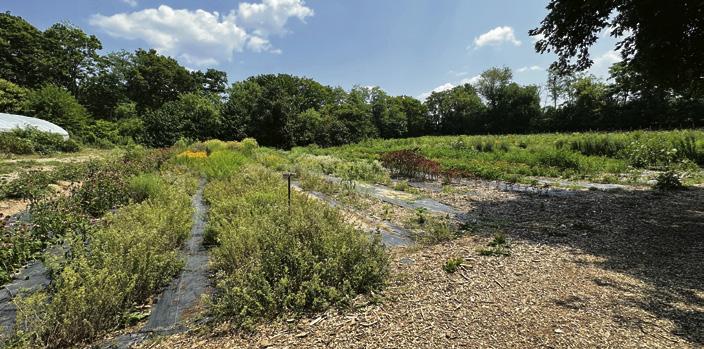


stone, in the shape of a heart and placed perfectly in this meaningful location of the farm.
What I learned about this special community, being the Homefield, was this is a special place where Education is always ongoing. Where a unique group of people can find Jobs, Food, Housing, and Volunteerism, in learning about Conservation. With over 147 educational workshops and seminars so far in their
“Experience Homefield” program still giving, in the hopes of feeding and educating others. In all of that, we find Love & Community. I hope you find out how special the Homefield is, as I did, and will assist them with your support in their endeavors. If you wish to learn more about Homefield you can visit their website to learn more at www. homefields.org.
Be well, be involved, and stay positive!

By Clinton Martin
Every so often I peruse the website of Elizabethtown College’s Young Center for Anabaptist and Pietist Studies. It is clearly recognized in Lancaster County and beyond as the center of academic study of the Amish and other anabaptist faith groups. A wealth of information about the Plain People is contained in their fabulous library, and their website is the most trusted source I’ve found for population statistics on the Amish. They also, of course, help promote upcoming books about Anabaptist themes. Occasionally, my visits to the website result in a purchase, and such was the case with “Fianna’s Story” by Nancy L. Bieber (Masthof Press.) This book was not about an Amish person,
but rather about a woman named Fianna Meyer (maiden name Bucher) who attended the Old Order German Baptist Brethren Church. Fianna was Nancy’s grandmother, though she never met her, as Fianna died quite young. Bieber was able to write the book, discovering who her grandmother was not through personal recounting but rather through a treasure trove of artifacts, notes, and other personal effects found in the attic during a clean-out.
Many visitors to Lancaster County have heard of the Mennonites and the Amish, but I would venture to guess most have not encountered the Old Order German Baptist Brethren. This conservative church group, part of the Anabaptist umbrella of sects, is just one of many lesserknown Plain congregations.
Fianna lived from 1886 to 1915, so the fact her family used a horse and carriage as transportation would not have set her apart from the more mainstream neighbors around her. Yet, everyone that lived around her family would have easily identified them as Plain. Their manner of dress would have made that clear. Interestingly enough, her father, though staunchly conservative in the religious sense, was rather rebellious in one way against the Old Order traditions. That is, when it came to education, he was determined that his children would not end their formal education with grade 8, and he intended for each of them to indeed go on to college.
Fianna’s father helped start a school and was one of the first trustees… none other than Elizabethtown College, which opened with its first class in 1900. One of Fianna’s brothers was in that inaugural class. Being younger, she didn’t enroll until 1907. As a “freshman” at the college, age 21, she enrolled for a 12-week term. Tuition was $12. Renting the dorm room to stay in was $6. And the meal plan at the cafeteria was $33. She did receive a discount of $4.80 since her father was a minister in the church. She had gone to primary
school from first grade through eighth grade but had not attended school between that time. That was not all that uncommon back in those days, and Elizabethtown College did not require incoming students to have a high school diploma before arriving. I would imagine that has changed in the ensuing 124 years.
Fianna met her husband Samuel Meyer at Elizabethtown College. He was of the same Old Order background, and to be honest they probably knew each other before going to college, or at least were acquaintances. Still, Bieber uncovered in various letters, postcards, that their romance and betrothal blossomed while at the college. In 1910, after Samuel graduated with two degrees from the college, he and Fianna married. She had already obtained a teaching certificate earlier.
Unfortunately, their marriage was only too last five years, as Fianna passed in 1915. What took her so soon? The horrific ailment known as Tuberculosis. In turn-of-the-century the bacterial disease that most often attacks the lungs was unfortunately very common, and also uncurable.
Today, TB still exists in America, but it is treatable, and has been on a decades-long downward trend, only having a small spike during the COVID19 outbreak when healthcare resources were diverted to addressing the pandemic.
In the book, Bieber details Fianna’s journey (by train) to White Haven, New York. There was a Tuberculosis Sanitorium there, which was a state-ofthe-art facility for “consumption” (as TB was called then) patients. While they practiced the most advanced forms of treatment available to physicians of that era, unfortunately a lot of it was simply quack medicine. Most of the staff at the sanitorium were survivors of TB, and thus had natural immunity to the disease and were unlikely to contract it from the patients.
While some people did recover, most did not. The mortality rate was terribly high. Being a woman of faith, Fianna wrote in her letters back home that she was relying on a higher power to either
Fianna cont’d on page 29

With the purpose of celebrating what will soon be harvest time in Lancaster County. I thought it would be nice to share some of the many recipes “Amish Country News” has cultivated and shared over the years. I hope you enjoy them as much as we did…
Barny’s Blue Crab & Corn Chowder
Ingredients
2 Cups Butter
2 Cups AllPurpose Flour
1 Cup Red Peppers, Diced 3/8”)


3/4 Cup Old Bay Seasoning
3 Bay Leaves




Repurposed by
Edward Blanchette
6 Cups Half & Half
2 Quarts 2% Milk
3 Cups Sweet White Corn
1 LB Claw Crabmeat
Instructions
Melt butter in stock pot. Add Old Bay and bay leaves. Stir in flour to make a roux, cook and stir till roux reaches a light caramel color. Add half and half and stir throughout. Add diced red peppers and allow to thicken, stirring frequently. Stir in 1 quart of the milk and allow to continue to thicken while adding the second 1 quart of milk. Stir in crabmeat and corn. Cook over med/high heat until hot throughout, approximately 20 minutes. Makes 4 quarts.
•
Strawberry Wheat Vinaigrette
Ingredients
2 Cups Strawberry Wheat
½ Cup Honey
2 Tbsps Dijon Mustard
1 Cup Strawberries (cleaned & trimmed)

2 Cups Balsamic Vinegar
3 Each Shallots (sliced thin)
4 Each Garlic Cloves
3 Cups Blended Oil
Salt & Pepper To Taste
Instructions
In a blender, mix all ingredients, except oil. When smooth, turn blender back on and slowly drizzle oil into mixture. Season to taste.
“Gold Medal” Chili
Ingredients
1½ Cups Fresh Seeded Tomatoes, Pureed (canned tomato puree may be substituted)


1½ Cups Fresh Seeded Tomatoes, Diced (canned diced tomatoes may be substituted)
1 LB Ground Beef
12 Oz LBC Milk Stout (any full-bodied
beer may be substituted)
1 LB Beef, Diced (roasted prime rib, flank or sirloin may be substituted)
32 Oz Kidney Beans, Rinsed
12 Oz Northern Beans, Rinsed
24 Oz Baked Beans
2 Green pepper, 3/8” Dice
2 Red Peppers, 3/8” Dice
2 Fresh Jalapeño P{eppers, 3/8” Dice
2 Chipotle Peppers, Fine Dice
4 Onions, 3/8” Dice
2 Tbsp Worcestershire Sauce
2 Tbsp Chili Powder
1 Tsp Cumin
2 Tsp Oregano
½ Tsp Cayenne Salt To Taste
Instructions
Combine ground beef, onions, bell peppers, garlic, jalapenos and chipotle, season with salt & pepper and cook over medium heat, making sure to break up ground beef. Add remaining ingredients except beans and bring to a boil. Reduce heat and simmer for 90 minutes. Add beans and simmer for an additional 30 minutes. Garnish with shredded cheddar and a dollop of sour cream and serve. Makes one gallon.
Grandma’s Old-Fashioned Apple Dumplings
Ingredients
6 Medium Baking Apples
2 Cups flour
2½ Tsp Baking Powder
½ Tsp Salt
2/3 Cup Shortening
½ Cup Milk
For the Sauce:

2 Cups Brown Sugar
2 Cups Water
¼ Tsp Cinnamon
¼ Cup Butter
Instructions
Peel and core apples. Leave whole. Mix flour, baking powder, and salt. Cut in shortening until particles are the size of small peas. Sprinkle milk over mixture and press together lightly, working dough only enough to hold together. Roll out dough and cut into 6 squares. Place an apple
on each square. Fill the cavity with apple with sugar and cinnamon. Pat dough around apple to cover it completely. Fasten edges securely on top of apple. Place dumplings 1 inch apart in a greased baking pan. Combine brown sugar, water, and cinnamon in saucepan. Cook for 5 minutes, remove from heat, and add butter. Pour sauce over dumplings. Bake at 375° for 35-40 minutes. Baste occasionally during baking. Serve hot with milk.
Bread
Ingredients
31/3 Cups Flour
2 Tsp Baking Soda
3 Cups Sugar
1 Tsp Salt
1 Tsp Nutmeg
1½ Tsp Cinnamon
¼ Tsp Cloves

Mix the above dry ingredients, then add the following:
1 Cup Vegetable Oil
4 Eggs
2/3 Cup Water
2 Cups Cooked or Canned Pumpkin
Instructions
Mix until well blended. Place in 2 large greased and floured loaf pans. Bake at 350° for 1 hour.
Amish Hats
Ingredients
½ Cup Butter
½ Cup Peanut Butter
1¼ Cup Sugar
2 Eggs
2 Cups Flour
1/3 Cup Milk
1½ Tsp Vanilla
1½ Tsp Salt
½ Cup Cocoa

2 Tsp Baking Powder
Large Marshmallows
Mocha Frosting (mix together):
1/3 Cup Cocoa
1/3 Cup Brewed Coffee
1/3 Cup Margarine
1 Tsp Vanilla
Add 3 cups powder sugar and beat well.






Instructions
Mix in order given. Drop on cookie sheet and bake 8-10 minutes at 350°. When almost done, remove from oven and press half of a large marshmallow on each cookie and return to oven for one minute. After cookies are cooled, spread with mocha frosting.
Cucumber & Onion Salad
Ingredients
5 Large Cucumbers (peeled and sliced thin)
2 Medium Onions (peeled and sliced thin into ringlets)
¼ Tsp Salt
½ Tsp Black Pepper
¼ Cup Sugar
3 Tb Vinegar
1½ Cups Mayonnaise
Instructions


11/2 Cups ICC Sesame Soy Marinade
8 Carrots (cut in half)
2 Onions (cut in quarters)
4 Potatoes (cut into chunks)
2 Bay Leaves (optional)
Instructions
Store in air-tight container overnight in refrigerator. Serves 16-20 people.
Levi’s Favorite All Day
Slow Cooker Roast Beef
Ingredients
1 Beef Roast (5-12 lbs any cut from chuck to sirloin will do)

Spray a medium sized Slow Cooker with non-stick cooking spray. Pierce roast beef thoroughly with a fork or steak knife to create deep cut for marinade and put into the slow cooker. Add 1 & 1/2 cups ICC Sesame Soy Marinade for roasts weighing 5-8 lbs. Use 2 cups ICC Sesame Soy Marinade for roasts weighing 8-12 lbs. Add carrots then potatoes. Cover and cook small roast on low 5-8 hours; large roast cooks overnight for about 8-12 hours until fork tender. Slow cooker temperatures cooking times may vary. Make this recipe in the morning before going to work or at night before going to bed and come home to this ultimate treat.
Southwest Style Beefy Wraps
Ingredients
Large Tortillas (flour, corn, whole wheat, etc.)
ICC Sweet or Hot Red Pepper Jam






Chopped Lettuce or Mixed Greens
Sliced Roast Beef (or ground taco beef or chicken)
Your Favorite Sliced Cheese
Sliced Tomatoes
ICC Barn Raisin’ Buffalo Sauce
1 Jar ICC Corn Salsa
Optional: Sliced black olives, hot or isweet peppers, chopped onions, etc.
Instructions
Spread any ICC Pepper Jam on flour tortilla. Thinly layer lettuce, sliced roast beef, cheese and tomatoes, sliced black olives, hot peppers, onions, etc. Top with ICC Barn Raisin’ Buffalo Sauce. Roll wrap and cut in half for easy serving. Southwest Style Beefy Wraps can be made up ahead of time, wrapped and refrigerated for several hours. To serve as appetizers cut up into 1½” to 2” slices. Serve chilled ICC Corn Salsa as a side dish.
Baked Cabbage & Cheese
Ingredients
1 Large Head
Cabbage
1 Tbsp Sugar
3 Tbsp Flour
2 Tbsp Butter, Melted
1 Cup Milk
1 Tsp Salt
1 Tsp Pepper

1 Cup Swiss cheese, Shredded
1 Cup American Cheese, Shredded
1 Tbsp Chopped Fresh Parsley
Instructions
Core and cut cabbage into 1”x2” pieces. Par boil cabbage by dropping it into water to cover, allowing it to cook for 5 to 7 minutes. Drain and cool cabbage. Mix cabbage and all ingredients except cheese. Pack into a shallow 4 quart Baking dish. Spread cheese over the top of the cabbage mixture. Bake at 350 degrees for approximately 20 minutes or until cheese begins to brown. Garnish the finished casserole with chopped fresh parsley.
Although thousands of visitors come to Lancaster County to experience a bit of the Amish lifestyle, the Amish are a private people and find the attention somewhat disconcerting. It is important to respect their feelings while you’re visiting. With that in mind, here are a few tips for fostering good relations between the Amish and non–Amish.
NO PICTURES Please! Don’t ask an Amish person to pose for a picture. Most will politely refuse. It is against our Amish neighbors convictions to have their pictures taken, except in very special situations. Please respect this belief and do not take photos without permission, just as you would like to have your beliefs respected.
HOLD YOUR HORSES Driving along area roads, you will no doubt encounter numerous Amish carriages, or “buggies,” as visitors like to call them. Do not honk your horn, because the sound may frighten the horse and cause an accident. Instead, wait until it is safe to pass and then give the buggy plenty of room. Be sure not to cut back in the lane too sharply in front of the horse. The county’s roads are generally wide enough that you should be able to pass most buggies without much of a problem.
NO TRESPASSING Do not trespass onto private Amish property for a closer look. Amish homes are not museums, and Amish people are not exhibits. Respect their property and privacy as you would like others to respect your own. You can get a good sense of Amish life at many area visitor attractions and on guided tours.
WAVING Do not be offended if the Amish do not wave back to your friendly gesture. With all the people who wave to them throughout a day, they would be waving back all day if they did!
A FINAL WORD Remember the Amish are not on vacation and are not costumed actors. They are real people going about their daily lives. They are not here to serve as tour guides or attractions for visitors. This, after all, is their home, so please respect their beliefs and lifestyle.












By Ed Blanchette
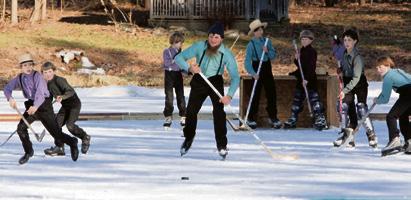
The Olympics have finished up and closed out for what was a spectacular showing of athleticism and sportsmanship! Congratulations to all of the athletes that participated from around the world! Football has commenced and soon Basketball, Hockey, and the World Series of Baseball will be upon us. All walks of people no matter where you are in the world, most have an interest in one sport or another. That includes Amish Country as well.

The Amish, especially the youth, enjoy an array of sports and outside entertainment to stay active and fit. What? Did you think all the Amish did all day, was work on their farms and fields to stay fit? I think not! Just like you, the Amish and Mennonite communities enjoy sports as an outlet for fitness and entertainment. Many sports come to mind that are enjoyed within those

communities. Some of which you may have never heard of. Depending on the region of Amish Country you are in, throughout the United States, there are an array of sports and activities that take a part of the interest and enjoyment of

the Amish communities. Most commonly known are baseball & softball, volleyball, soccer, hockey, basketball, and bike riding. There’s also fishing, ice skating and sledding, depending on the season. For more of a family friendly event, lawn croquet, cornhole and shuffleboard are also a great go to option.
Another favorite sport mostly played by the Amish and Mennonite communities in Lancaster County Pennsylvania, not always spoken of as much as those other conventional sports is corner ball, also known as “eck ball”. Though it may be decreasing in popularity elsewhere, it’s still played in

our neck of the woods and at one time was referred to as, “the plain people’s equivalent of NCAA March Madness.” Unlike organized league sports, corner ball is a definitive plain game that requires nothing more than a small leather ball, an empty cow pen or lot, and a dozen or so willing participants. Kind of combining hackysack and dodgeball. The game calls for two teams of six players, who attempt to eliminate each opposing player by hitting them with the leather covered ball. Participants usually play in a barn yard, covered in with a thick layer of straw, known as the mosch, which provides a soft surface to duck, dive, and roll to avoid getting hit with the ball.
So, there you have it! I hope you are now enlightened about the world of Amish and sports. Sometimes we all need a bit of an outlet for fun. Whether you’re Amish, Mennonite or English, it’s a great way to incorporate some sport or exercise into your life for fun and fitness. That for sure, is definitely a plan for good health and success, which is always a homerun with me. Stay safe, stay well, and stay positive and enjoy each other.
Ephrata, a small yet influential town, derives its name from Genesis, meaning “fruitfulness.” With a population of 13,800, it’s strategically positioned between Lancaster and Reading, serving as the gateway to Northern Lancaster County’s lucrative manufacturing sector.
Its history dates back to the 18th century Ephrata Cloister, founded by Conrad Beissel, which evolved into a thriving village. By 1871, Ephrata was described as “a well-built country town of about one hundred and twenty families, and very beautifully and healthily located.”
In 1848, Senator Joseph Konigmacher established the Ephrata Mountain Springs Hotel, a luxurious resort frequented by notable figures like Presidents Lincoln, Buchanan, and Grant.
A trolley system was built to connect the hotel with the town of Ephrata down the hill. At its peak, the hotel could accommodate up to 500 visitors who would stay throughout the summer.
The Reading & Columbia Railroad was completed in 1883, and the town experienced economic booms through industries like cigar manufacturing, horse trade, silk, textiles, and shoes. Downtown Ephrata once catered to all needs, from groceries to hardware.
Today, Ephrata retains its historical charm with landmarks standing as important reminders of the borough’s history. The community’s first bank, Ephrata National Bank, still serves customers today behind its Georgian
style structure designed by renowned architect, C. Emlen Urban.
Located near the town’s square sits the circa 1880’s railroad station, owned by the Ephrata Borough and serving as home to Mainspring of Ephrata, economic development corporation for the borough. The area surrounding the station has been beautifully landscaped and is known as the Whistle Stop Plaza. Many events, services and even weddings are held at this popular gathering place. The community’s Welcome Center is also located in this building. From here, visitors and residents alike can download a historic walking tour through the Uniquely Ephrata app.
Recreation thrives with facilities like the Ephrata Rec Center, community pool, and the newly opened Ephrata Unleashed Dog Park. The Warwick-Ephrata Rail Trail and Heatherwood Bike Park offer outdoor
activities, while quality education and healthcare are ensured through the Ephrata Area School District and award-winning Wellspan Ephrata Community Hospital.
Municipal services include police, code enforcement, and utility management, with the borough’s own electric company providing power.
Ephrata is experiencing some significant revitalization that will secure a vibrant, healthy town for future generations. The borough, under the auspices of Mainspring of Ephrata, completed a walkability project in the downtown area that enhanced pedestrian safety, and launched a Façade Improvement Grant Program and Revolving Loan Fund Program to improve aesthetics and help businesses to expand. The borough continues to strengthen the economy by promoting available leased space within commercial properties, attracting specialty retailers, and preserving historic buildings.
The borough’s commitment extends to preserving natural assets like the Ephrata Mountain, exploring plans for hiking trails and conservation easements to enhance community living. It is from this 200 acres of public wooded land that the healing waters flowed all those years ago to the Mountain Springs Hotel.
Ephrata continues to thrive as a fruitful community, blending its rich history with modern amenities for residents and visitors alike.




WITNESS the emotional story of an Amish teenager's struggle in Jacob's Choice, where he must choose between his faith and the modern world. 3–D sets, special effects, unique "ghost–like" characters, all on five screens.
EXPLORE the Amish Country Homestead, the region’s only Officially Designated Heritage Site Amish home then sit at a desk in the Fisher Amish Schoolroom furnished authentically with desks and more from an actual Amish classroom.
TOUR the magnificent back roads through Amish Farmlands with a certified tour guide in complete comfort onboard one of our 14 passenger busses.
SATISFY yourself that you’re making the most from your Amish Experience. Since 1959, the area’s first, and still foremost, interpretative source of Amish Culture.






Journey along back country roads, deep into the Amish Farmlands to discover sights rarely seen. Under the watchful eye of your certified guide, you’ll gain insights into the “how” and “why”of an ever–changing culture, and see at–the–moment activities of the Amish. If you’ve seen the Amish portrayed on the various “Reality” TV shows, and you wonder what really is true and not true about the Amish, this is the tour you won’t want to miss! We’ll debunk myths about the Amish and provide accurate, respectful, and authentic information, just like we have done for over 60 years.
Duration: 1 1/2 hours
Mon.–Sat. 10 a.m., 12 p.m., 2 p.m., 4 p.m. Sun. 12 p.m., 2 p.m., 4 p.m.


Rare is the opportunity to meet with Amish families willing to share their traditions and beliefs with you. In a group whose size is never more than 14, this is the only Amish Tour to be designated an official “Heritage Tour” by the County of Lancaster. Visit an Amish farm at milking time, stop at a Cottage Industry, and finally enjoy a visit and chat with one of our Amish friends in their home.
Duration: 3 hours Monday – Saturday 5:00 p.m.



The SuperSaver Package includes the Amish Farmlands Tour, the acclaimed “Jacob’s Choice” at the Amish Experience F/X Theater, and a tour of the Amish House & One–Room School.
Drive along the area’s only AAA Scenic Cultural Byway, and when you’re mid–way between Bird–in–Hand and Intercourse, you’ll discover the ten pristine acres known as Plain & Fancy Farm, and home of the Amish Experience Theater, Country Homestead, farmlands & VIP tours, buggy rides, shopping, restaurant and hotel.

Discover what it means to be Amish through an immersive film as you become part of the emotional struggle of the Fisher family to preserve more than 400 years of Amish traditions. Five viewing screens, a unique barnyard setting and special effects create a one–of–a–kind experience.
Journey down rarely traveled back country roads, deep into the farmlands, to discover the sights sought after by visitors. Gain insights into the hows and whys of an ever–changing culture from certified guides in mini–shuttles. Stops may include a roadside stand, quilt shop, country store or craft shop on an Amish farm.

Visit the only officially designated “Heritage Site” Amish house. As you walk through the nine rooms with your guide, unravel the riddle of Amish clothing, life without electricity, and eight–grades–in–a–room education as you sit at authentic Amish school desks.

This officially designated “Heritage Tour” is a rare opportunity to meet and talk to the Amish personally. On this exclusive tour you will go right into the barn on an Amish farm at milking time, visit with an Amish artisan at his workplace, and then enjoy a personal visit and conversation right in an Amish home.

Aaron & Jessica’s drivers are happy to share life stories and answer questions.
Smokehouse
Please see right hand page.
Find books, DVDs, candles, toys and dolls, kitchen and home items, souvenirs, local handcrafts, Amish clothing, straw hats, bonnets, and last but not least...tasty treats.

Rated The Best Hotel in Lancaster County
The place for the perfect adult-only getaway or family vacation with indoor pool, hot tub, fitness center, and hot hearty breakfast. Our rooms and suites all feature kitchenettes, and many rooms feature clawfoot soaking tubs, and farmland views.
Adult-Only AND Kid-Friendly Buildings
The family-friendly East Building includes a wide array of beautiful, award-winning rooms, suites that are newly renovated as well as a pool and arcade that will satisfy the requirements of any family. The adultsonly West Building features elegant Grand King rooms with clawfoot soaking tubs and guaranteed farmland views – fulfilling the needs of adults seeking a tranquil escape.
Complimentary Hot Breakfast Buffet
Lancaster’s best complimentary hot breakfast buffet includes made-to-order omelets, eggs, and waffles along with endless helpings of bacon, sausage, country potatoes and much more. Plus, don’t forget tasty bakery items from our own Miller’s Bakery. Menu items subject to change.
Other Amenities
Every room or suite includes a kitchenette with refrigerator, microwave, sink and coffee maker. Plus, DVD players, lighted make-up mirrors, irons, hair dryers, the Tarocco line of shampoos and soaps, and complimentary Wi-Fi. Plus, there are so many things to do on the Plain & Fancy Farm.
Get the Whole Story at: AmishViewInn.com • 1-866-735-1600
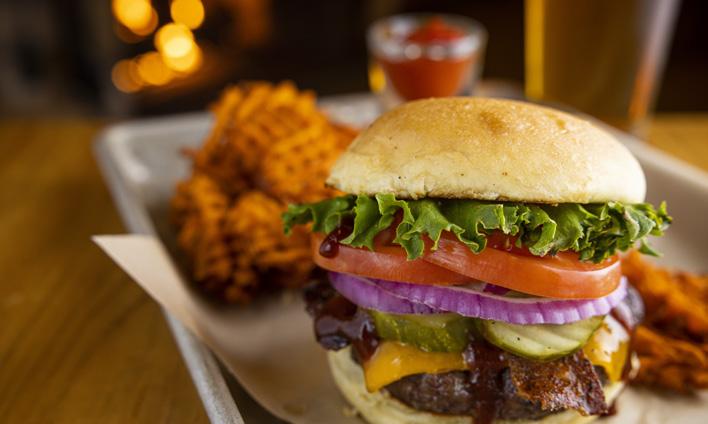
A fun and relaxed dining experience in the heart of Lancaster County at Plain & Fancy Farm, offering entrées with smoked meats, grilled fish and steak; sandwiches; house made sauces; and more. Local favorites and meats smoked low n’ slow pair perfectly with our selection of local beer, wine, and hand-crafted cocktails. Locally owned.
Valid for up to 6 adult sandwiches, entrées, or platters for dine-in only. Not valid on daily or other specials, Family Feast, takeout, holidays, or with any other offer, special or group rate. Expires 10/15/24. PLU ACN757 3121 Old Philadelphia Pike • Bird-in-Hand, PA 17572 Walk-Ins Welcome | Reservations Accepted | Takeout Available Open Monday, Wednesday, Thursday, Friday, Saturday and Sunday 800-669-3568 or visit SmokehouseBBQandBrews.com


By Clinton Martin
Lancaster County is known far and wide, around the entire globe, due to the Amish community rooted here, and by extension the pastries, pies, and cakes that the community produces are famous. Shoo-Fly Pie comes to mind. Whoopie Pies do too. But Bob and Andy Pie? That’s a new one for me.
Turns out Bob and Andy Pie is a famous Amish dessert linked entirely to the midwestern US Amish populace. While Pennsylvania is top of the pile,
as far as the State with the most Amish people, there are population centers in Illinois, Indiana, and Missouri, and those are the regions where the pie with such a funny name is most popular.
The legend of the name stems from an Amish man who wanted to praise the pie his wife had made, to show just how delicious he found it, by comparing it to the best thing he owned… Bob and Andy. Bob and Andy were his excellent and hardworking, beautiful and powerful gelding draft horses. So, commending
the baker on the taste of the pie as being “good as Bob and Andy” certainly did bring across just how much he loved that slice of sugar and spice.
The pie is a sweet custard style confection made with eggs (lots of eggs!) and milk, cinnamon, cloves and of course plenty of sugar. You aren’t likely to find recipes to make your own in PA Dutch cookbooks. You’ll need to look online if you want to try your hand at baking your own “Bob and Andy Pie.”


New Holland, settled in 1728 by John Diffenderfer of Heidelberg, Germany, is located in the fertile farmlands of Lancaster County. It is a charming small town similar to many towns in rural America, but its story goes back to well before the founding of our nation.
The unstable situation in Europe in the late 1600s spawned and nurtured the pioneer interest in the deep forest lands of Pennsylvania—60 miles inland from Philadelphia. In 1681 William Penn received his 40,000 square-mile land grant to settle King Charles’ debt to his father. The area now called New Holland was practically covered by virgin forests— sturdy timber of oak, ash, chestnut, and walnut.
By 1728, William Penn, had been dead for 10 years and his American colony, called Pennsylvania and was being administered by a proprietary governor while the sale of land was formalized by patent deeds. In the case of one of the town’s early settlers, John Diffenderfer, the record shows that he applied for land to live on in 1728. It was surveyed and placed on the county map in 1735. The deed was finally issued to him on March 22, 1758 after 30 years!
The village founders were German, not Dutch. They were surrounded by English and Welsh Quakers, Episcopalians, a few Swiss-German Mennonites and some Scotch-Irish Presbyterians. The Amish arrived later.
The town was once known as New Design, a name given by
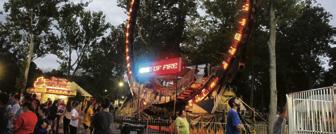
Michael Diffendefer for his real estate development in 1750. But in 1802, when a post office was established and an official name was necessary, there was no dissension to naming the town New Holland. These grateful people remembered how extremely kind the inhabitants of Holland were to them when they fled persecution and sought religious freedom in the New World.
New Holland was laid out as a “street town” in the typical European style of having the villagers live in a central location along both sides of the street, but each having an
outlying plot of land to cultivate as an adjunct to his trade as a craftsman. Even today, the main street of New Holland has major “kinks” or bends in it. Unsympathetic visitors claim it looks as if the town were built along a “cow path.” But if one looks with a discerning eye, the street also follows the high ground. The land on the ridge was the driest, and in winter it would be blown clear of much of the snow. These settlers made the obvious facts of nature work for them rather than against them, offering a lesson for us all even today.







Bird–in–Hand Pg 30
Intercourse Pg 28
Paradise Pg 34
Strasburg Pg 26
New–Holland | Blue Ball Pg 23
Lititz Pg 40
Ephrata Pg 17
Coffee & Bakery Shops

Renninger’s

The area we know today as Strasburg was first settled by German-speaking Swiss Mennonites. After bargaining with William Penn in London, they came directly to Philadelphia from the Rhineland, arriving in September of 1710, on board the ship Maria Hope with a combined passenger and crew list of 94 persons. Thirty-six of the leaders were granted patent deeds
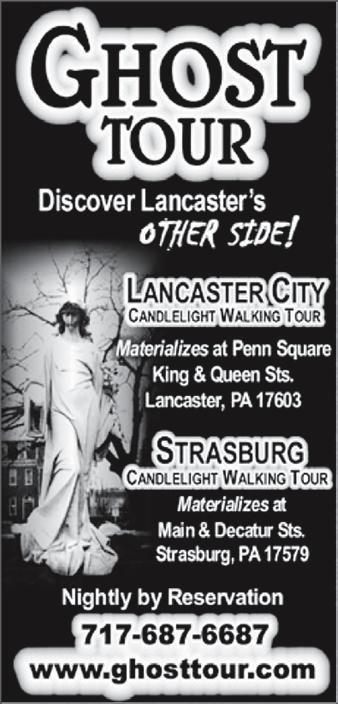

from Penn’s property commissioners for 14,000 acres of land surrounding Strasburg. Some of the family names are familiar to locals today, including John (Hans) Herr, whose house in Lancaster County is open to visitors and remains as the county’s oldest surviving dwelling (1719).
French fur traders opened up the first path through this area from Philadelphia to the Susquehanna River—known as “Minqua’s Path.” As early as 1716, when the first Conestoga wagon was used for hauling goods between Philadelphia and Lancaster County, it became known as the Conestoga Road.
During the next half century, traffic on this road increased

September 25, 26 & 27, 2024
851 Village Rd Lampeter, PA
The 3-day event provides friendly competition among neighbors and a wholesome, educational atmosphere for all ages. Farmers and small gardeners can compare their produce at one central location. Children can learn to appreciate quality food products and farm animals. For more information: westlampeterfair.com.
considerably—and Main Street Strasburg was developed. The first buildings appeared in the village about 1733. Strasburg flourished in the 18th century primarily because of its location along the major wagon routes between Philadelphia, Lancaster and the Susquehanna River. Strasburg was one of the principal stopping stations and, with the heavy wagon traffic, there were as many as ten taverns here.
No doubt the religious nature of the first settlers was responsible for the village becoming a center for worship and education. In 1816, when the village was incorporated into a Borough, the name Strasburg was selected, undoubtedly named for the Cathedral City from which the
a guided tour of Lancaster County’s Amish Country.

Swiss Mennonites came, the Alsatian city of Strasbourg.
Wealthy doctors and clergy, and an interest in worship and education, made Strasburg a cultural and educational center for the region. The first formal school opened in 1790, a classical academy where Greek and Latin were taught.
These academic enterprises were followed during the 19th century by a flood of schools. In 1823, by an act of the Legislature of Pennsylvania, an Academy was established in which “the languages, arts, and sciences will be taught.”
The year 1839 marked the founding of the Strasburg Academy at 37 East Main (the present day Limestone Inn Bed & Breakfast was the headmaster’s home and housed boarding students). The Academy gained the reputation of being one of the best academies in the country for both boarding and day


students, and its students came from all over the East Coast and as far away as Cuba and Puerto Rico.
In 1841, a classical school for girls, the “Strasburg Female Seminary,” opened at 17 East Main. Such a school for girls was quite unusual at that time.
As Strasburg flourished, so did its neighbor to the east, Philadelphia. The commercial interests of Philadelphia pressured the State Legislature to improve the transportation network into their city. As a result, an internal improvements bill passed in 1826 to construct a series of canals. The Philadelphia and Columbia Rail Road was also incorporated with financing provided by the state.
With these undertakings, Strasburg residents became alarmed at the possibility of losing their commercial position and from this concern emerged the Strasburg Rail Road.





2024 Photo Contest Now Accepting Entries! Got great photos? Send them to us and see your photo in the pages of Amish Country News and win prizes! Visit AmishCountryNews.com for Photo Contest prizes and more info. Email your HIGH RESOLUTION ONLY photos in JPG format to clinton@amishexperience.com (minimum size 8x10 at 300 DPI). Put 2024 Photo Contest in the subject line. File names should contain your name. Include your name, address and phone number with brief details of location and subject matter in the email. No more than five photos can be submitted. LOW RESOLUTION PIXELATED IMAGES WILL NOT BE ACCEPTED. Photos become property of Amish Country News / Amish Experience and may be used in upcoming issues, publications, and promotional materials.
In 1832 a charter was secured from the Pennsylvania Legislature to construct a rail line connecting Strasburg with the Philadelphia and Columbia Rail Road main line near Paradise. Due to financial difficulties, the project was delayed until finally put in running order in 1852. But this shortline between Strasburg and Paradise was not financially successful for many reasons, until it was revived to provide rides to visitors on authentic steam locomotives, thus becoming the focal point for all of the town’s train attractions.

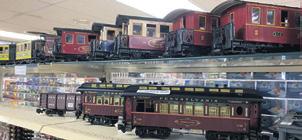



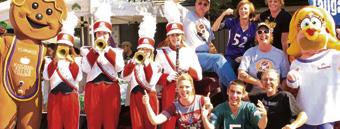
September 20–21, 2024
3529 Old Philadelphia Pk, Intercourse, PA
Every year Kitchen Kettle Village pays tribute to tailgating season with a 2-day food festival. Full of Food and Events for the whole Family. This year, see scarecrows throughout the village and vote for your favorite. Tap your toes to live music.
For more information visit kitchenkettle.com/ events/tailgating-festival-events-andactivities.asp or call 800-732-3538.
Probably no other town in Amish Country can claim its fame is owed largely to one simple thing—its name. For years people have sent letters home with the name stamped boldly on the envelope… Intercourse, PA. There are several explanations for the name, and they are woven into the brief history that follows.
In the beginning, of course, there was very little here, just settlers arriving in the New World from Europe. Back around 1730, the Old Provincial Highway (or Old Philadelphia Pike, Route 340) was laid out to connect Philadelphia with the inland town of Lancaster. Conestoga wagons, pulled by six to eight horses, hauled supplies and freight back and forth between the


two cities. Providing rest for travelers and horses, taverns sprouted along the way, becoming centers for news, gossip, and business transactions.
And that is how the town got started when the first building, a log tavern, was constructed in 1754. The Newport Road, a former Indian trail, came from Newport, Delaware to the south, and it is believed that because of these intersecting roads the tavern took “Cross Keys” as its name. That was true at least until 1814, when it was named Intercourse in a real estate scheme to establish a more sizable town. George Brungard had acquired 48 acres of land north of the roads in 1813. He attempted to lay out a town site and divide it into sections for sale by a lottery, advertising “151

handsome building lots of $250 each to be drawn for by number.”
The newspaper advertisement stressed “the great importance of so many turnpikes and great leading roads intersecting at and near this place.” As one writer has noted, in those days “intercourse had a common usage referring to the pleasant mutual fellowship and frequent intermingling which was so much more common in the informal atmosphere of the quiet country village of that day.” There was no hesitancy on the part of the United States Post office Department to accept the name ‘Intercourse’ since it meant a commercial or trading site.
But back to our story and Brungard’s scheme. Although lotteries had been
PO Box 414 • Bird–in–Hand • PA 17505 717.768.8400, ext. 217
AmishCountryNews.com
Published by Dutchland Tours Inc.
Clinton Martin, Editor–in–Chief clinton@amishnews.com
For advertising information contact Edward Blanchette
Director of ACN & Business Development ed@amishnews.com • 717.344.0871
Tammy Johnson, Graphic Designer
290,000 copies distributed annually by subscription, and over 200 hotels, motels, information centers and businesses in PA Dutch Country. Copyright ©2024 All contents of this magazine are protected by copyright and may not be reproduced without prior approval of the publisher.
used for many years to sell various things, his real estate lottery failed, and most of the land was combined into one tract. More recently, in 1971, another person tried to take advantage of the town’s name and sell one-inch square plots of property to visitors. This plan proved to be a flop as well.
In the old days, there were only five houses, counting the inn, and the town grew slowly. But by 1880, Intercourse had 54 homes and a population of 280. Communications improved with the arrival of the post office, and later the telephone.
Getting the first post office up and running was a difficult matter. The main problem was finding a building and someone willing to perform the duties of a postmaster. The first, Benjamin Fraim, performed his duties from the Cross Keys Tavern, and may have had a job working there, since “his income, based on a percentage of the postal transactions for the year ending 1829 was only $8.21.” Over the years the post office moved among stores or restaurants whose owners hoped visits by residents would increase their business.
The local stagecoach service apparently started around 1898. It was “a single horse conveyance similar to a market wagon, with a roll-up curtain and double set of seats.” The stagecoach brought items from Lancaster City for local Intercourse businesses, and even picked up milk, butter, and eggs for delivery to Lancaster restaurants and industries, including an ice cream plant. One history of Intercourse notes that when it snowed,
a bobsled was used instead. “When the driver knew of passengers beforehand, their comfort was added to by many a hot brick heated the night before in the oven, and wrapped in newspaper to preserve its warmth.”
As the days of the dirt road drew to a close, so too did the stagecoach days with the Rowe Motor Truck service started by Coleman Diller in 1910. In 1923 the Penn Highway Transit Company was organized and initiated bus service to Lancaster. It is noted that “many of the Amish residents of the area were anxious to see the line started, but did not care to subscribe to stock. Instead they liberally bought books of tickets which were really prepaid bus fares.” By 1924 enough money was raised to buy a Mack Auto Bus for $6,800. It held 25 passengers and even had solid rubber tires!
Since the town never really got to be “too large,” it has retained much of its sense of community, from the little public library in a former one-room school to the volunteer fire company. Surrounded by farms, the town has grown little and retains much of its former charm, even when thousands of visitors descend upon it during the tourist season.
Many residents and visitors enjoy the atmosphere of this small town, a place where family, community, religion, and hard work are still important values. The village of Intercourse has certainly changed over the years, but it has changed slowly, and “sometimes the things that grow the slowest are the ones that endure the longest.”
Fianna cont’d from page 11
see her through, and returned to them in health, or to see her on to Heaven.
Part of Bieber’s work in preparing the book was to research tuberculosis in the early 1900’s. What were the symptoms. What were the treatments. How did the disease progress from inception to death. Thus, she is able to write about how Fianna most likely experienced the ailment, even though there are no letters during the downward spiral of her health. It was an ugly way to go in America, and we can be thankful that modern medicine in this century is able to treat the condition so much better.
The book is a very interesting read, because you see a slice of Plain Church life at the turn of the century, and through the many letters curated and reprinted in the book, you truly feel like you’ve met Bieber’s grandmother, and see through her eyes her journey of love, grief, and faith. Even though their marriage was only five years long, the couple did have 3 children, and you see how they progressed through losing their mother, welcoming a housekeeper named Hannah to help Samuel with keeping the house and raising the children.
If you wish to purchase your own copy, you can do so through the Young Center, or by contacting Masthof Press directly.





September 6 & 7, 2024
Ronks Rd, Bird-in-Hand
More than 2,000 runners from around the world come to be a part of BIH Half. Discover a community known for its oldworld practices and hard-working people.
For more information for September 6 visit bihhalfmarathon.com/course/#5k
For more information for September 7 visit bihhalfmarathon.com/course/#halfm
Of the many unique village names that dot the Amish Country map, one of the more interesting is Bird-in-Hand.
The story of the town of Birdin-Hand is as colorful as the name itself. To be correct, the town is really a village since it has no governing body. When Bird-in-Hand celebrated its 250th Anniversary (1734 – 1984), a commemorative booklet was put together. It outlined a brief history of the town…
William Penn, an English Quaker, had founded the colony of Penn’s Woods (Pennsylvania), and settlers began arriving from Europe in the early 1700s, moving westward from the port city of Philadelphia. English
Quakers and Swiss Mennonites were the early settlers. The Quakers built a meetinghouse and two-story academy, which stands today, next to the fire company. But over the years, the Germans “made the greatest lasting impact.”
A friendly relationship existed between the early settlers and the Shawnee and Conestoga Indians, who were the area’s first inhabitants. They taught settlers how to deaden trees, use deerskin, prepare corn as food, and use medicinal herbs.
“When the Old Philadelphia Pike became a well-established route of transportation for those traveling west to the Alleghenies,
Lancaster became known as the gateway to the west.” The trip by stagecoach for passengers, or Conestoga wagon with freight and merchandise, lasted several days. Inns were built every few miles, identified with signs held by an iron pole or attached to the side of the building.
The reason for these signs was twofold. First, they could be understood by all nationalities. Secondly, many teamsters or waggoneers were poorly educated and could not read. If they were given orders to stop at a certain inn, they could do so by recognizing the artwork on the signboard.
Bird–in–Hand cont’d on page 32
























By booking either VIP (Visit-in-Person) Tour or Meal-in-an-Amish-Home Experience online at AmishExperience.com with promo code VIPW5.
Amish Visit-In-Person Tour (3 Hrs.)
$61.95 adult, $51.95 child (age 6-12*)
* Children under age 6 not permitted on VIP Tour
Stop 1: The Amish Farm Observe the milking process and discover “Amish electricity” as you learn that the Amish do not milk cows by hand.
Stop 2: Amish Cottage Industry As the Amish population grows, more Amish turn to home businesses rather than farming. Visit an Amish workshop to see what they make and how they make it.
Stop 3: The Amish Home We’ll go to the home of one of our Amish neighbors for friendly conversation…a chance to sit, chat, and visit the Amish way.
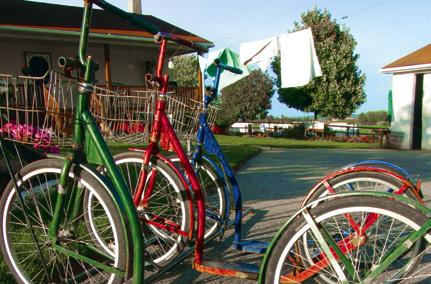
Enjoy a 3–HOUR Experience featuring a traditional Amish Family-Style Meal, served in an Amish home.
$65.95 per person regardless of age*
* Small children must be in a car seat you provide.
The old legend of the naming of Bird-in-Hand concerns the time when this pike was being laid out. Legend says that two road surveyors were discussing whether they should stay at their present location or go to the town of Lancaster to spend the night. One of them said, “A bird in the hand is worth two in the bush,” and so they remained. The sign in front of the inn is known to have once “portrayed a man with a bird in his hand and a bush nearby, in which two birds were perched,” and soon was known as the Bird-in-Hand Inn.
The original hotel was destroyed by fire about 1851. By the following year, a three-story hotel was built to replace it. More recently, it was known as Bitzer’s Hotel before becoming the present Village Inn of Bird-in-Hand, now on the National Register of Historic Places. The Historic Preservation Trust of Lancaster County noted that it “may be one of the few 19th century inns in the context of a small town in Lancaster County, which survives with a high degree of architectural integrity.”
The town post office was established in 1836 as the Enterprise Post Office. “Enterprise”
was then the official name of the town, until the final change back to Bird-in-Hand in 1873.
After a large fire in 1896, people discussed the need for a fire company. In the early days, hitting a circular saw alerted the men of a fire. The year 1916 saw the change from horse-drawn to motorized fire equipment. Today the Handin-Hand Fire Company remains a volunteer organization, famous for its delicious fund-raiser dinners.
The town of Bird-in-Hand remained relatively unknown until a musical called PLAIN & FANCY opened in New York. The show Playbill noted that “The action takes place in and around Bird-in-Hand, a town in the Amish country of Pennsylvania.” The cast was brought to Bird-in-Hand on January 17, 1955, prior to the official opening.
Today, the town of Bird-inHand is still small, said to have a population of only about 300 people. On any given day, there may be more visitors than inhabitants. Many are city folks who have come to enjoy the country atmosphere, history, and shopping. It is said that visitors “can still expect friendly shopkeepers, homegrown Lancaster County foods, and restful lodging for weary travelers.”
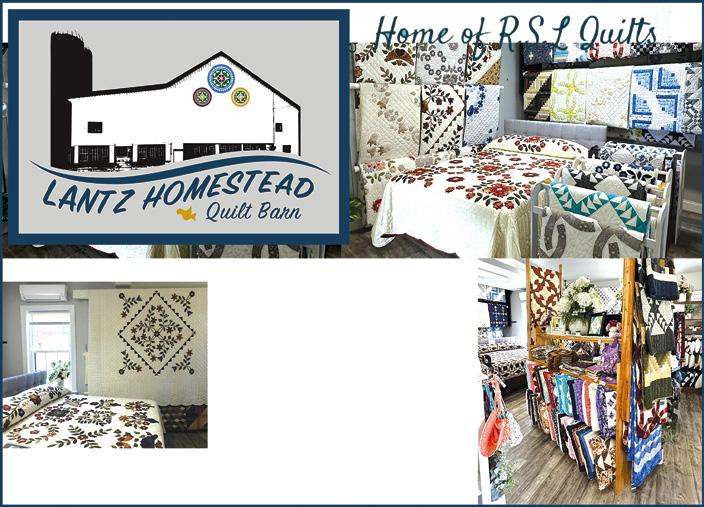



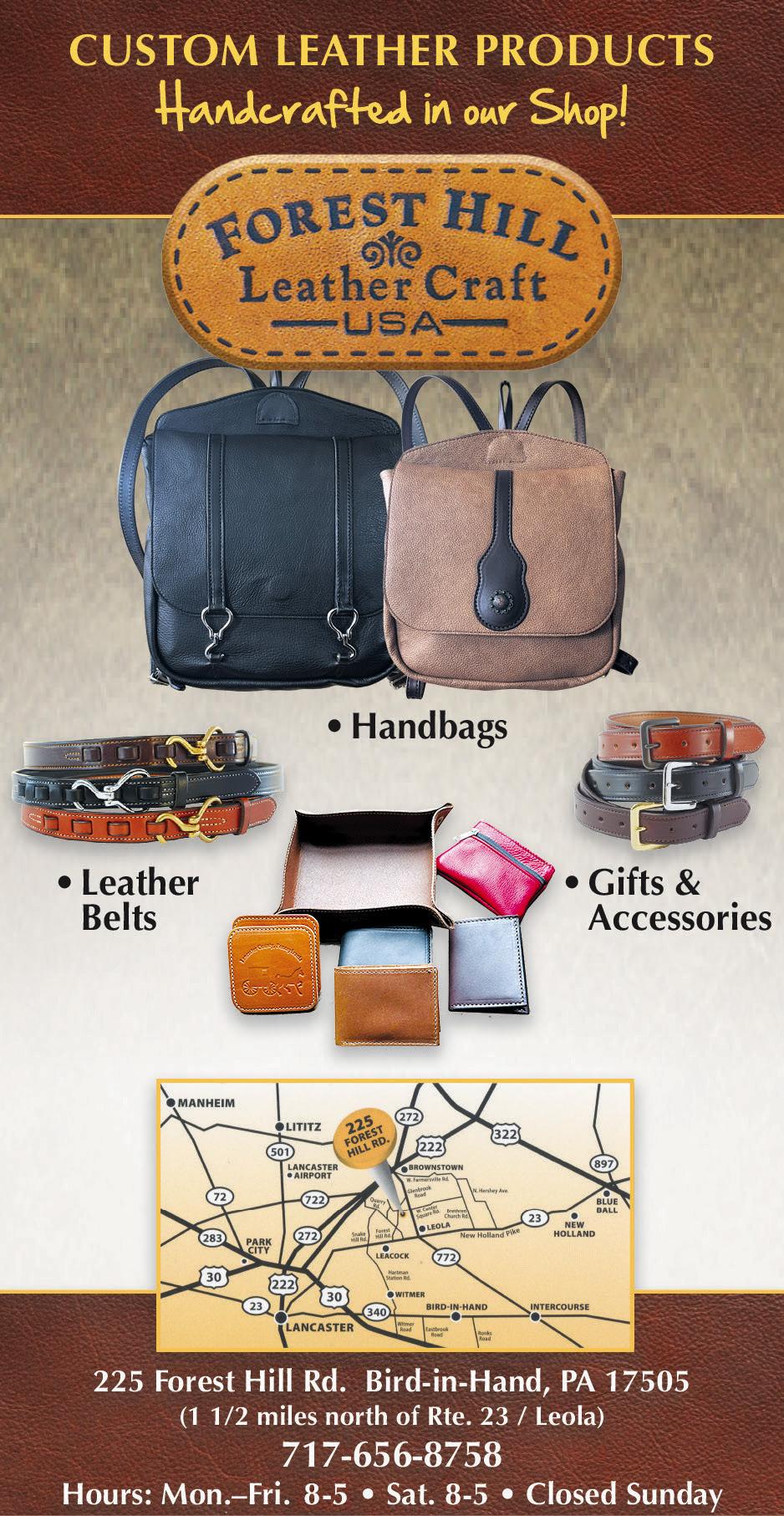

For over 250 years, visitors coming into Lancaster County from the east on Route 30 have traveled through a small town known as Paradise, just one of the many intriguing town names in the area. Officially, Paradise Township adopted the name during its organization in 1843.
Different sources credit different people with naming the area. Some say that the name Paradise was given by Joshua Scott, who later became
known for his map of Lancaster County. Standing in the middle of a road admiring his surroundings one day in 1804, he remarked that the town should be called Paradise, because its beauty made it seem like one.
The story of Paradise and its first settlers goes all the way back to Europe, to the area of the Palatinate in Germany. Here many Protestants had settled following the declaration of King Louis XIV that all Protestants

September 29, 2024 10 am–6 pm 495 Mark Drive, Elizabethtown, PA
Join us for a day filled with fun, food, and festivities. The event will feature live music by The Uptown Band, delicious food vendors, live/silent auctions, hatchet throwing, and exciting games for all ages.
For more information visit facebook.com/ events/849258053272829/?_rdr
in France would be persecuted. With fears of invasion by the army of France looming, many of these people decided to accept the invitation to settle in William Penn’s colony of Penn’s Woods in the New World. In 1708, Daniel Fierre (Ferree), along with his family and mother Mary, went to England to obtain citizenship papers before proceeding to New York.













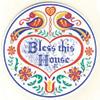


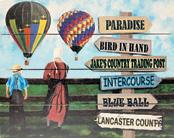


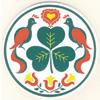

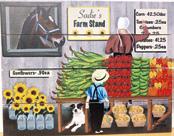


CACKLEBERRY FARM ANTIQUE MALL IS CELEBRATING THEIR 27TH YEAR! Located at 3371 Lincoln Highway East, Paradise, Pennsylvania, on Route 30. Four miles west of Route 41 and only six miles east of Rockvale Square Outlet Mall. They are only minutes away from everywhere and everything Lancaster County has to offer. It's Not Just an Antique Mall –It’s Your Destination!
WITH OVER FIVE MILLION DOLLARS OF INVENTORY, their huge 26,000 square foot facility houses a wide variety of antiques and collectibles, displayed by over 125 dealers featuring fine items such as: furniture, glassware, Railroad, Mining and Fire Fighting Memorabilia, coins, sterling silver, clocks, advertising, jewelry, fine china, toys, books, postcards, trains, Christmas, pottery, linens, primitives, kitchenware & much, much more! It is impossible to tell you everything they have to offer. You will be amazed at the quality selection.
HOUSED INSIDE THE ANTIQUE MALL, IS AN OLD TIME GENERAL STORE, which will take you back in time to the Mom & Pop stores of years ago. With a wide variety of antique and collectibles including Pharmacy, Tool Supply, Barber Shop, Hardware Store, Haberdashery and more!! They offer convenient parking for over 100 vehicles, with a spacious area for campers, trailers, and tour buses. You will find it such a pleasure to shop in their clean, climate-controlled, brightly lit and carpeted mall. Absolutely one of The Best shopping experiences in Lancaster County!
OPEN ALL YEAR: MONDAY THROUGH SATURDAY 9:30 AM to 5:00 PM, SUNDAY 10:00 AM to 5:00 PM, closed on Tuesday. Visa / MasterCard / Discover / Debit Cards accepted. Gift Certificates, Layaway and Shipping Available. For more information call: (717) 442-8805 during business hours or visit us on at CackleberryFarmAntiqueMall.com.
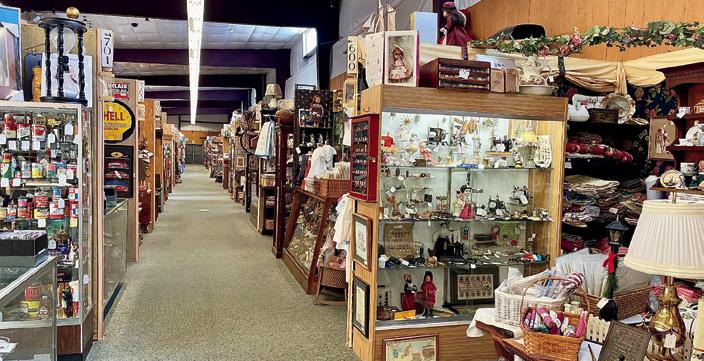
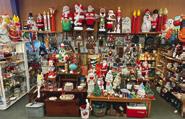


We have everything Lancaster County has to offer Come explore our huge 26,000 square foot antique mall—filled with the finest selection of antiques and collectibles in Lancaster County Pennsylvania! It houses a huge assortment of merchandise by over 125 dealers. There’s so much to choose from it’s impossible to list it all. And don’t miss our old time general store that’s full of vintage merchandise for sale.








By 1712, these French Huguenot settlers had secured land in Pennsylvania, in Lancaster’s Pequea Valley. They were the first white people in the area and lived peaceably with chief Tanawa and the local Indians. Mary Fierre died four years later at the age of 63. Hers became the first grave in the family’s cemetery. If you ride the Strasburg Rail Road, you
will pass her gravesite at Carpenter’s Cemetery, one of Lancaster’s oldest.
The origins of Route 30, also known as the “Lincoln Highway,” go back to Lancaster’s colonial days when this frontier county needed a communication route between it and the provincial capital of Philadelphia. At that time, the first “planned” road between Philadelphia and Lancaster
TUESDAY, SEPTEMBER 24, 2024
6:00pm | Doors Open at 5:30pm Shady Maple Banquet & Conference Center
$65 per person


was what is now Route 340. It was called the “King’s Highway,” and today we still call it the “Old Philadelphia Pike.”
As time went on, it became evident that the road could not accommodate the increasing traffic between Lancaster and Philadelphia. Since the cost of such a road was too much for the state to undertake, the company charged with building it was given the power to demand “reasonable” tolls from users. Investors received dividends earned from the tolls collected along the gates of the turnpike.
The 1792 Act went on to describe the construction of the highway, which was to be a bed of small crushed stones on top with larger stones underneath, rather than dirt, so as to prevent carriage wheels from cutting into the soil. Such a revolutionary system of road construction combined the ideas recently developed by a Frenchman and two Englishmen, one of whom was named John McAdam. We now take the term for paved roads or “macadam” from his last name. The turnpike officially opened in 1795 and was the first long-distance, hardsurfaced road in the country.
The backroads around Paradise remain beautiful to this day, as the lush greens of the summer give way to the fall colors of the harvest season. So, during your visit to Lancaster, be sure to spend a little time in Paradise.




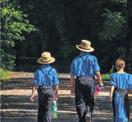





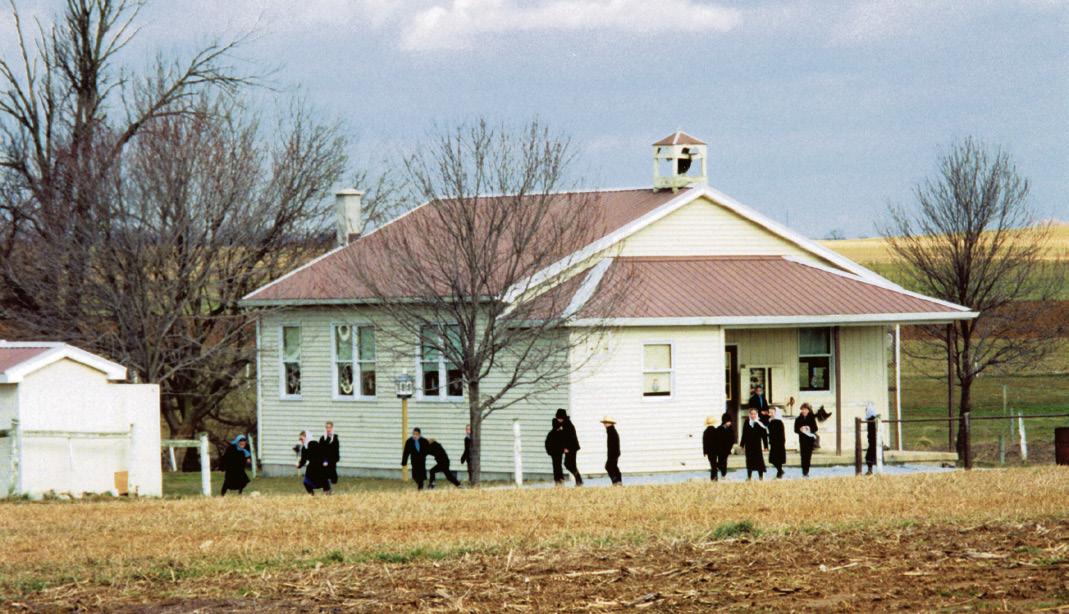
While driving by some of the approximately 300 Amish one-room schools in the Lancaster Amish settlement, visitors often wonder what a typical day is like in these private schools. Here is an “inside look” adapted from the comments of an Amish schoolteacher...
Who are the teachers?
School is typically taught by young Amish women in their late teens or

early 20s, who teach for several years before getting married. No one usually teaches after marriage; it is too big of a commitment. There are some women who never marry, however, that may continue to teach.
How many students and teachers are there in the school?
Schools are usually one room, one teacher, although occasionally there
is a helper in schools of more than 30 pupils. (Special schools for students with learning or other disabilities often have one teacher per four pupils.)
Usually there are 25-30 “scholars”

from grades 1-8, and ages 6-13. They may start at the age of five if their birthday is before the end of the year.
How long is the school term and day?
We have a 180-day term, with five 7-hour days. School usually begins around 8:30 am. There are 15-minute breaks in the mid-morning and mid afternoon. Then, there is a one-hour break at lunch, which includes recess. There are four class periods of about an hour and a half in length, two in the morning and two in the afternoon.
What subjects do you teach and how?
Lessons taught include arithmetic (not math), and we often use
agricultural arithmetic books printed in the 1930s. Lots of drill games and flash cards are used, especially for the lower grades. Workbooks are used for most subjects.
Spelling is drilled well with spelling words being assigned for use in sentences and written many times in
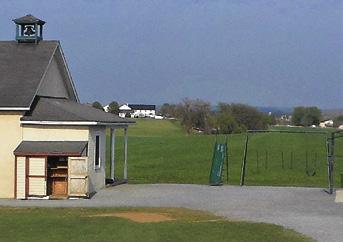
an exercise book to practice for the test, which is given orally at the end of the week.
As for reading, the first grade learns phonics, sounding out the letters rather than recognizing words. By Christmas they are reading out of Readers, either McGuffy, Dick & Jane, or another series from the Amish publishing house in Canada that uses Amish themes and illustrations. Every grade has reading once a week “in class.” The first and second grades read “in class” daily. Pupils stand up front of the class in order of age and

take turns reading by sentences or paragraphs, depending on the grade. When a scholar who is reading makes a mistake, if another student notices, he will raise his hand. The teacher will call on him and he will mention the error, be it mispronunciation, skipping or adding words, etc. Students are so eager to do this that the teacher very seldom has to correct them.
Amish children learn to speak English in school, since they speak the Pennsylvania German dialect at home. English lessons are taught twice weekly in all grades, including parts of speech, vocabulary, etc. And by the way, English is usually spoken in the classroom and on the playground, with exceptions made for a first grader who is not very fluent yet. First graders usually know some English before they get to school but may not be really fluent at the start of the year.
Many a scholar’s favorite subject is American History, with special emphasis on the early days of our

Geography/Social Studies is also taught, with the best students learning the States and their capitals. Penmanship is considered to be very important. And German starts in the second or third grade, beginning with recognition of the German alphabet and advancing to German reading and comprehension in the upper grades.


What is a typical day like in your school?
A typical day starts with the teacher reading a chapter from the Bible. Then students rise and say the Lord’s Prayer. Students file to the front and sing three or four songs from the songbooks. The teacher has arithmetic assignments on the board for grades three to eight daily. The teacher begins with first and second grade phonics or reading. Each class is taught for about 10 minutes, “hands” are answered between classes. During recess, softball is usually played whenever weather permits. Smaller children play tag, prisoner’s base, jump rope etc. On rainy days, ping-pong, board games, or party games are played inside. At lunchtime, a prayer is recited in unison. A story is read to all after the lunch recess. Classes continue in the afternoon. At dismissal, a goodbye song is usually sung.
There is vocational training after grade eight, until one session past the student’s 15th birthday. While students work and help their parents at home, they keep a journal of their activities. And once a week they meet with the teacher, where they further their German studies.
What about discipline?
Discipline varies among the teachers, but parents are notified of an unusually disrespectful child.
Please Note: Amish schools are, of course, private, and not open to the public.
Amish VIP (Visit–in–Person) Tour
717–768–8400 | AmishExperience.com
Dutch Apple Dinner Theatre
717–898–1900 | DutchApple.com
Gish’s Furniture
717–392–6080 | 717–354–2329 | Gishs.com
Ghost Tour Lancaster & Strasburg 717-687-6687 | GhostTour.com/strasburg.html
Good’s Store
“Weekdays Only” | GoodsStores.com
Hershey’s Chocolate World 717–534–4900 | Hersheys.com
Jake’s Country Trading Post 717–687–8980 | JakesHomeAccents.com
Miller’s Smorgasbord
800–669–3568 | MillersSmorgasbord.com
Shady Maple Farm Market
717–354-4981 | Shady-Maple.com/farm-market/
Shady Maple Smorgasbord
717–354-8222 | Shady-Maple.com/smorgasbord/
Smokehouse BBQ & Brews at Plain & Fancy Farm 717–768–4400 | SmokehouseBBQandBrews.com
For Plain People, Sunday is a day of rest, but there are many things to do in Amish Country on Sundays. Save some of these for your Sunday sight–seeing.
Aaron & Jessica’s Buggy Rides
717–768–8828 | AmishBuggyRides.com
Amish Experience
717–768–8400 | AmishExperience.com
Cackleberry Farm Antique Mall
717–442–2600 | CackleberryFarmAntiqueMall.com
Choo Choo Barn
717–687–7911 | ChooChooBarn.com
Dutch Apple Dinner Theatre
717–898–1900 | DutchApple.com
Hershey’s Chocolate World
717–534–4900 | Hersheys.com
Jake’s Country Trading Post
717–687–8980 | JakesHomeAccents.com
Julius Sturgis Pretzel Bakery
717–626–4354 | JuliusSturgis.com
Miller’s Smorgasbord
800–669–3568 | MillersSmorgasbord.com
Renninger’s Antique Market
717–336–2177 | Renningers.net
Shupp’s Grove
717– 484– 4115 | ShuppsGrove.com
Smokehouse BBQ & Brews at Plain & Fancy Farm
717–768–4400 | SmokehouseBBQandBrews.com
Strasburg Scooter Tours
717–876–5560 | StrasburgScooters.com
Turkey Hill Experience
844–847–4884 | TurkeyHillExperience.com

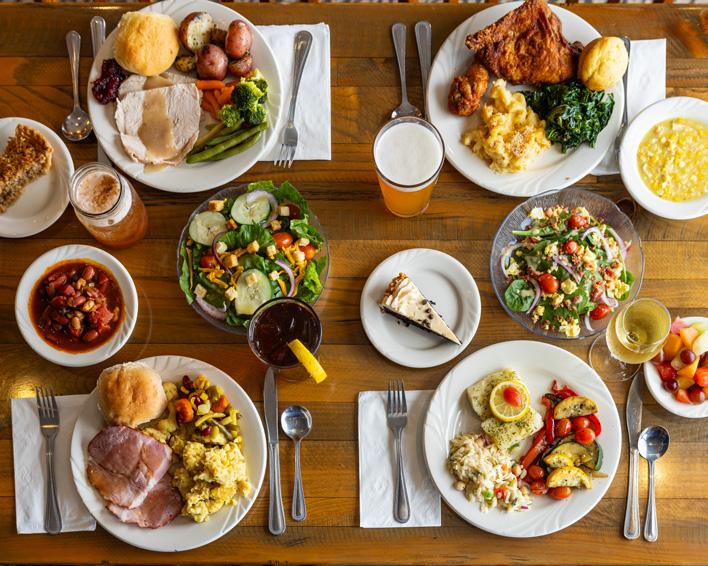

Voted a LNP Lancaster County Reader’s Choice Buffet 2023, a 2024 USA TODAY 10Best Readers’ Choice Best Buffet in the US, TripAdvisor’s Travelesr’ Choice 2023, and a Lancaster’s Best Buffet by Clipper Magazine 2023.
bord

There really is no place quite like Lititz, and everyone should plan to spend some time there while in Amish Country.
Lititz Springs Park is a popular spot for locals, and the site for many community activities. Indeed, the town’s 4th of July Celebration, begun in 1818, is reputedly the “oldest continuing community-wide observance in the United States.” The Lititz story is tied to that of the Moravian faith in Bohemia. It was in the present-day Czech Republic that John Hus and followers founded the Moravian Church in 1457. Historians note that since this was 60 years before Luther’s Reformation, the Moravians may lay claim to being the oldest organized Protestant Church. But over
the course of the Thirty Years War, its 200,000 members nearly disappeared. In the 18th century, a renewal of the Moravian Church came through the patronage of Count Zinzendorf of Saxony. He invited all those persecuted for their faith to come to his lands in Saxony.
As was the case with other persecuted religious groups in Europe, many Moravians sought freedom by taking the perilous journey to the New World, arriving in the early 1700s, with the main settlements becoming established in Pennsylvania and North Carolina.
Missionary work was integral to the faith, and preachers were sent from the Moravian community in


September 7 & 8, 2024
Join us for a weekend filled with fun, food, and entertainment. There will be a daily air show, aircraft on display, food trucks, a kids’ area, and so much more. Parking is free. General admission tickets
be purchased online, with children 15 and under free. Take your experience to the next level with premium seating options available for purchase. For more information visit lancasterairport.com/ airshow or call 717-569-1221.
Bethlehem, Pennsylvania. Zinzendorf himself arrived in America in 1742. A local resident, John Klein (Kline), was so moved by hearing Zinzendorf’s preaching that he made arrangements to transfer his lands over to the Moravian community in 1755. It was in the following year that the town actually got the name of Lititz, the German spelling for Lidice, where European Moravian reformers had taken refuge in 15th century. For about a hundred years, Moravian church members were the only people permitted to live in the town. A Brothers’ House and Sisters’ House were erected for the unmarried men and women, although they did not live communally. It was not until 1855 that non-Moravians were allowed to own their own houses.
The Brothers’ House played a role in the American Revolution. George Washington ordered it used as a military hospital between 1777-78. Some 1,000 soldiers were nursed here, about half of whom died and were buried nearby.
One name is linked forever with the history of Lititz—Julius Sturgis. It was Sturgis who opened the first commercial pretzel bakery in the New World in Lititz. The year was 1861, and the site at 219 East Main Street is on the National Register of Historic Places.


A tour of the bakery is unlike any other. Inside, you get to try your hand at pretzel twisting. It’s not as easy as it looks. Guests also may see the old brick bake ovens, as well as the more modern facilities. Schedule a tour by calling the bakery at 717-626-4354.

By Edward Blanchettet
Well, we finally made it! For most people Spring and Summer are usually the go-to season most people reference as their “Favorite”, as seasons go. I’ll concede that they have their place and perks, spring with its promise and renewal of life after a long winter, shedding the winter garb and the fresh air that rushes in when you open up the house, after many months of being closed up. Then there’s summer, with its adventure of vacations and schools being out, water sports & beaches, and ice cream on the porch on a long hot summer’s day.
But for me, it’s Fall! There are many reasons I personally love this season. Just a few to consider are cooler temps, the foliage changing color across the land, corn mazes & bon-fires, the smell of pumpkin spice and potpourri in the air and so on. But what is the thing I love most about fall?
Baked goods! That wonderful smell that travels through the air and tickles your nose with curiosity and makes your tummy growl with anticipation. Cakes, pies, cookies, breads, and all of those other wonderful, tasty treats that come out of those ovens. It just makes me giddy knowing they’re just a taste away. Ahhh, you can bet with certainty in “Amish Country”, that there’s an oven of a local bakery firing up and producing those wonderful, tasty morsels of fall, some simple, some elaborate, but all tasty.
Couple that with a little bean that is big business, to small business, in most places within the United States, that gives you that must have pairing of coffee. Coffee was invented way back in 750 AD, by accident, by Kaldi, who was believed to have lived in the Great Rift Valley of Ethiopia in East Africa. The origin story of coffee in America is believed to have been introduced by Captain John Smith, the founder of the Colony of Virginia, when he shared it with other Jamestown settlers in 1607 after learning about it in his travels to Turkey. Surprisingly, coffee’s popularity did not take off right away. It is also believed that the English may have also introduced the coffee drink into the New York colony between 1664 and 1673. The earliest reference to coffee in America is 1668[87], at which time a beverage made from roasted beans, and flavored with sugar or honey, and cinnamon, was consumed in New York.
From the times of introduction and experiment of then, what was coffee, to the now of what we currently consume in 2024. What is known as the little giant of at least 100 different types of coffee bean species that have been selectively bred and refined for hundreds of years to end up as a particular craving in your cup, not necessarily just for morning. The kinds of coffee are technically divided into three, according to where they came
from, and the variety of the beans used to make the brew. The basic kinds of coffee are one-origin, one-estate, and blends. Coffee is made up, primarily, of two different types of beans, Arabica, or Robusta. The basic type of coffee includes Cappuccino, Latte, Americano, Espresso, Macchiato, Flat White, Mocha, Vienna, Long Black Coffee, Affogato, Irish Coffee, and Iced Coffee. Just to name a few.
So, how many bakery and coffee shops are there in Pennsylvania, let alone Central Pennsylvania? It’s hard to say, as numbers are always changing. I’m sure they’re an eye opener that may keep you up at night. Between Diners, Bakery’s, National Chains, and Specialty Coffee shops, Mom & Pop or otherwise, baked goods & coffee are definitely well represented in many different locations throughout Central Pennsylvania and throughout the United States. But all that being said, it comes down to where you prefer to frequent in your local area. So, here are just a few, small business locations, that I have come across in my travels through “Amish Country” that may entice you in your travels and become your cup of tea… er… coffee. Maybe try some, take a tasty sip and a morsel, should you wish to test one in our area. You can even try all of them out!
Note: See list of Bakeries & Coffee on the following page.












Beilers Doughnuts 398 Harrisburg Avenue, Lancaster, PA beilersdoughnuts.com/locations
Bird-In-Hand Bake Shop
542 Gibbons Road, Bird-In-Hand, PA bihbakeshop.com See ad on page 30
City Watch Coffee LLC 1501 East Cumberland Street , Suite 5, Lebanon, PA citywatchcoffee.com
Copper Cup Coffee 1 West Main Street , Mount Joy, PA coppercup.co
Dosie Dough 45 South Broad Street , Lititz, PA dosiedough.com/lititz
La Mattina Caffe 38 Deborah Drive, Leola, PA theinnatleolavillage.com/en/restaurants/ la-mattina-caffe
Mean Cup 398 Harrisburg Avenue, Lancaster, PA meancup.com
Mill 72
45 North Main Street, Manheim, PA mill72.com
New Holland Coffee Co 832 West Main Street, New Holland, PA newhollandcoffee.com
Timber Creek Coffee LLC 494 West Lincoln Avenue, Myerstown, PA facebook.com/people/Timber-Creek-CoffeeLLC/100094676199235















Twin Valley Coffee 1324 Main Street, East Earl, PA twinvalleycoffee.com
The Daily Grind Quarryville 21 West 4th Street, Quarryville, PA (Lancaster County) thegrindquarryville.com
Crave Café
4600 Penn Avenue, Sinking Spring, PA (Berks County) cravecafe.net
Zig’s Bakery & Café
800 East Newport Road, Lititz, PA zigsbakery.com
Scratch Bakes Cafe 3 West Main Street, Ephrata, PA scratchbakes.com
Mr. Sticky’s Homemade Sticky Buns 501 Greenfield Road, Lancaster, PA MrStickys.net
See ad on page 28
Hershey Farm Resort 240 Hartman Bridge Road, Ronks, PA facebook.com/hersheyfarm
Cake and Cup Bake Shoppe 12 West Newport Road, Lititz, PA facebook.com/cakeandcupbakeshoppe
Linden Coffee
2916 Old Philadelphia Pike, Ronks, PA drinklindencoffee.com
7 Brew
3582 Penn Avenue, Sinking Spring, PA 7brew.com/location/sinking-spring-pa
Riehl’s Quilts & Crafts 247 East Eby Road, Leola, PA riehlsquiltsandcrafts.com
Zook’s Homemade Chicken Pies 3427 Lincoln Highway East, Paradise, PA facebook.com/ZooksHomemadeChickenPies See ad on page 36 Philips Five with a Java Jive 740 Noble Street, Kutztown, PA www.facebook.com/p/The-Phillips-Fivewith-a-Java-Jive-100063544015363/









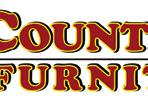



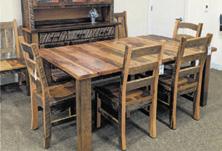
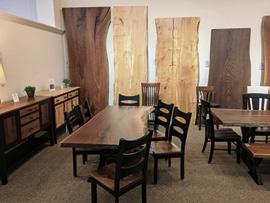









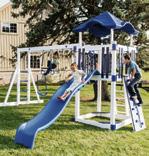
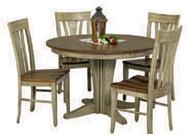











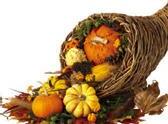











Monday-Saturday 9am-5pm, Sunday 10am-4pm*
*Last ride leaves 30 minutes prior to closing time.
Country & Cookie Tour
Adults: $18.00 Child: $12.00 (age 3-12) 2 & under: Free
A 30-35 minute tour passing a cluster of Amish homes and businesses in an all Amish area. Travel our country roads, the way we travel! Cookies, snacks and drinks are USUALLY available for purchase, depending on our Amish neighbors availability.
Adults: $35.00 Child: $16.00 (age 3-12) 2 & under: Free
A 50-60 minute tour that stops at a local farm! Experience our way of life on a real working Amish farm. Tour the barn and see the cows, chickens, goats, and horses. Discover life without electricity and how the Amish remain separate from traditional American society!
Adults: $20.00 Child: $12.00 (age 3-12) 2 & under: Free
A 30-35 minute tour passing numerous Amish farms. Our local drivers can answer your questions and talk to you about points of interest.
For a truly unique experience, book your own private tour, with your own driver, horse, and buggy. Our guests call it “ unforgettable”!











